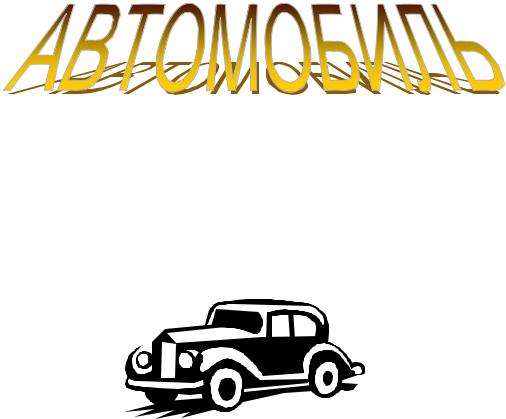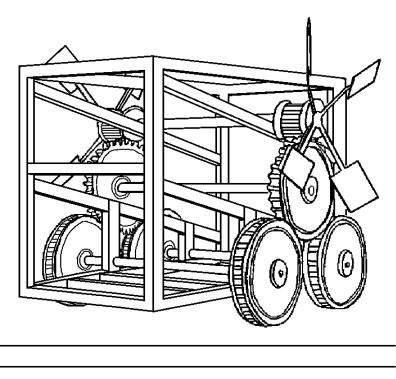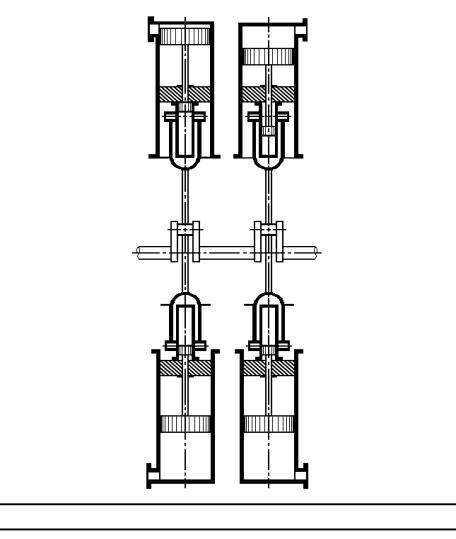
2395
.pdfУДК 42:629.114 ББК 81.432.1:39.3 Г 37
Рецензенты: заведующий кафедрой «Теплотехника и тепловые двигатели», доктор технических наук, проф. А.С. Ненишев;
заведующий кафедрой «Иностранные языки» Омского государственного института сервиса (ОмГИС), кандидат филологических наук, доцент С.Ю. Нейман.
Работа одобрена редакционно-издательским советом академии в качестве учебного пособия на английском языке для студентов вузов, обучающихся по специальностям: 150200 – Автомобили и автомобильное хозяйство; 240100 – Организация перевозок и управление на транспорте; 240400 – Организация и безопасность движения.
Герасимова Л.Ф.
Автомобиль: Учебное пособие на английском языке для студентов вузов, обучающихся по специальностям: 150200 – Автомобили и автомобильное хозяйство; 240100 – Организация перевозок и управление на транспорте; 240400 – Организация и безопасность движения. В 2 ч. – Омск: Изд-во СибАДИ, 2002.-205 с.
Учебное пособие разработано в соответствии с типовой программой курса «Иностранные языки в вузе» для студентов неязыковых вузов с учетом современной методики преподавания.
Книга состоит из двух частей, краткого англо-русского словаря с терминологией по специальности, а также приложения в виде денотатных карт на английском и русском языках.
Первая часть включает в себя разделы: «История возникновения и развития автомобилестроения», «Устройство автомобиля». Тексты и упражнения направлены на развитие у студентов навыков чтения и профессионального говорения.
Во второй части даны тексты о мировых марках современных автомобилей и предназначены для самостоятельного чтения.
Учебное пособие может быть использовано для подготовки аспирантов.
Л.Ф. Герасимова, 2002

Л.Ф. Герасимова
Министерство Образования Российской Федерации
Сибирская государственная автомобильно-дорожная академия (СибАДИ)
Л.Ф. Герасимова
АВТОМОБИЛЬ
УЧЕБНОЕ ПОСОБИЕ НА АНГЛИЙСКОМ ЯЗЫКЕ
ДЛЯ СТУДЕНТОВ ВУЗОВ, ОБУЧАЮЩИХСЯ ПО СПЕЦИАЛЬНОСТЯМ: 150200 – АВТОМОБИЛИ И АВТОМОБИЛЬНОЕ ХОЗЯЙСТВО
240100 – ОРГАНИЗАЦИЯ ПЕРЕВОЗОК И УПРАВЛЕНИЕ НА ТРАНСПОРТЕ
240400 – ОРГАНИЗАЦИЯ И БЕЗОПАСНОСТЬ ДВИЖЕНИЯ
Омск Издательство СибАДИ
2003
Учебное издание
Л.Ф. Герасимова
УЧЕБНОЕ ПОСОБИЕ НА АНГЛИЙСКОМ ЯЗЫКЕ
ДЛЯ СТУДЕНТОВ ВУЗОВ, ОБУЧАЮЩИХСЯ ПО СПЕЦИАЛЬНОСТЯМ: 150200 – АВТОМОБИЛИ И АВТОМОБИЛЬНОЕ ХОЗЯЙСТВО
240100 – ОРГАНИЗАЦИЯ ПЕРЕВОЗОК И УПРАВЛЕНИЕ НА ТРАНСПОРТЕ
240400 – ОРГАНИЗАЦИЯ И БЕЗОПАСНОСТЬ ДВИЖЕНИЯ
Компьютерный набор, дизайн и верстка ………………..
Редактор ……………….
Лицензия ИД №00064 от 16.08.99. Подписано к печати ___________. Формат 60x90 1/16. Бумага ксероксная. Оперативный способ печати. Гарнитура Таймс.
Усл. п. л. ___, уч.-изд. л.____. Тираж______экз.
Заказ . Цена договорная.
Издательство СибАДИ 644099, г. Омск, ул. П. Некрасова, 10
Отпечатано в ПЦ издательства СибАДИ 644099, г. Омск, ул. П. Некрасова, 10
|
CONTENTS |
|
|
PART ONE |
|
I. HISTORY OF THE AUTOMOBILE ……………………………….. |
6 |
|
|
The Power Struggle……………………………….. |
7 |
|
The Drive to Gain Acceptance……………………. |
9 |
|
Fast and furious…………………………………… |
9 |
|
Nader’s Legacy…………………………………… |
12 |
II. AUTOMOBILE |
|
|
Текст 1 |
Man in Motion…………………………………….. |
15 |
Текст 2 |
Automobile .............................................................. |
17 |
Текст 3 |
Automobile Structure .............................................. |
20 |
Текст 4 |
Motoring in England ............................................... |
22 |
Текст 5 |
2-stroke and 4-stroke Engines ……………………. |
24 |
Текст 6 |
Types of Engines …………………………………. |
26 |
Текст 7 |
Engine ……………………………………………. |
29 |
Текст 8 |
Plastic Engine Parts ……………………………… |
31 |
Текст 9 |
Types of Fuels …………………………………… |
32 |
Текст 10 |
Fuel System ……………………………………… |
33 |
Текст 11 |
The Operation of Engine ………………………… |
34 |
Текст 12 |
The Combustion Chamber ………………………. |
39 |
Текст 13 |
Piston …………………………………………….. |
42 |
Текст 14 |
Flywheel …………………………………………. |
45 |
Текст 15 |
Camshaft …………………………………………. |
47 |
Текст 16 |
The Cooling System; Air-cooled Engines………… |
49 |
Текст 17 |
Water-Cooled Engines ……………………………. |
53 |
3
Текст 18 |
The Thermostat. Overheating. Anti-freeze……….. |
55 |
Текст 19 |
Lubrication ……………………………………….. |
59 |
Текст 20 |
A Coil for Every Plug ……………………………. |
61 |
Текст 21 |
Functions of the Power Train ……………………. |
63 |
Текст 22 |
Clutches ………………………………………….. |
66 |
Текст 23 |
Types of Transmission (Gear-Boxes) …………… |
68 |
Текст 24 |
Transmissions with Fluid Couplings ……………. |
70 |
Текст 25 |
Torque Converters ………………………………. |
72 |
Текст 26 |
Universal Joints …………………………………. |
75 |
Текст 27 |
Rear Axles and Differentials ................................. |
77 |
Текст 28 |
Electrical Control ……………………………….. |
80 |
Текст 29 |
The Car of the Future …………………………… |
82 |
Текст 30 |
Car with a Dual Power Supply …………………. |
84 |
Текст 31 |
Automobile Alternatives? ………………………. |
85 |
Текст 32 |
Collectors Rally to Halt Old-Car Crushers ……… |
86 |
Текст 33 |
Future Developments ……………………………. |
87 |
Текст 34 |
Energy and Mass-Transportation of |
|
|
Passengers in Japan ……………………………… |
87 |
|
1. Urban Traffic in Japan ........................................ |
88 |
|
2. Transportation in Tokyo and Its |
|
|
Surrounding Areas………………………………… |
93 |
|
3. Urban Transportation System and |
|
|
Energy ……………………………………………. |
98 |
|
4. Future Plans for Urban Traffic ………………… |
100 |
|
PART TWO |
|
CLASSIC CARS |
|
|
Текст 35 |
Ford ………………………………………………. |
103 |
4
Текст36 |
General Motors Corporation ………………………. |
106 |
Текст 37 |
Ferrari 250GTO …………………………………… |
108 |
Текст 38 |
Mercedes-Benz 300SL ……………………………. |
110 |
Текст 39 |
AC Cobra …………………………………………. |
113 |
Текст 40 |
Alfa Spider ……………………………………….. |
116 |
Текст 41 |
Volkswagen Beetle ……………………………….. |
118 |
Текст 42 |
Volkswagen Passat ……………………………….. |
121 |
Текст 43 |
Jaguar ....................................................................... |
123 |
Текст 44 |
Jaguar E-type ........................................................... |
125 |
Текст 45 |
Lotus Elan ............................................................... |
128 |
Текст 46 |
Volkswagen Golf GTI ............................................ |
131 |
Текст 47 |
Austin Kealey 100 & 3000 .................................... |
134 |
Текст 48 |
Jaguar Mark II ........................................................ |
136 |
Текст 49 |
MGB ...................................................................... |
139 |
Текст 50 |
Mini ....................................................................... |
142 |
Текст 51 |
Ford Mustang ........................................................ |
145 |
Текст 52 |
Rolls Royce Silver Shadow ................................ |
147 |
Текст 53 |
Triumph TR4/TR5/TR6 ………………………… |
150 |
Текст 54 |
Citroen ................................................................... |
153 |
Текст 55 |
Mitsubishi .............................................................. |
154 |
Текст 56 |
Rover ...................................................................... |
155 |
Текст 57 |
Fiat ......................................................................... |
156 |
Текст 58 |
Peugeot 405 ........................................................... |
158 |
Текст 59 |
Mazda 121 ............................................................. |
159 |
VOCABULARY |
................................................................................ |
161 |
BIBLIOGRAPHY |
................................................................................ |
205 |
APPENDIX |
............................................................................... |
206 |
5
PART ONE
I. THE HISTORY OF THE CAR
There have been many inventions during the Twentieth Century – the telephone, air travel, television and the atomic bomb – are just four with universal impact. But one stands out from the crowd as having had more influence on more people in more places – the car.
The significance of the motor car to the recent history of civilization is beyond question. The car s precise date of introduction, however, will be debated for decades to come. That s because, ever since the invention of the wheel around 4000 BC, humans have tried to design a self-propelled machine to replace the horse.
Karl Benz and Gottlieb Daimler may have been credited with producing the first vehicles powered by the internal combustion engine in 1885, but the origins of the car go back as far as the Old Testament. This foretold of machines propelling themselves on land and the air. The great 13-th-century scientist and philosopher Roger Bacon predicted the advent of machine-powered vehicles on land and water, while Leonardo de Vinci s diagrams of a self-propelled carriage are a matter of record. In 1472, Roberto Valturio described a machine (рис. 1) designed for war purposes, which was to be moved by means of large windmills transmitting their motion through cranks and gears. Clockwork and windassisted vehicles all played their part in the pre-history of the car but the greatest influence came from the Steam Age. In the early 1760s Frenchman Captain Nicolas Joseph Cugnot built a powerful steam-driven tractor to tow artillery hardware. Only partly successful, it was left to a group of British, American and European inventors to pursue the development further. Of these, Richard Trevithick s London Carriage was both the most practical and effective.
The steam era saw, not only the advent of a succession of road coaches, but also the more recent railway locomotive. The former was handicapped by public resistance and government legislation, while those involved in the horse trade saw these new contraptions as a danger to their livelihood. This led not only to heavy taxation through toll roads but also the implementation of the Red Flag Act. This ruled that all forms of road locomotives should have a man with a red flag walking ahead of them. This ridiculous law was not repealed until many years later.
6

Wind-driven vehicle by Robert Valturio
Рис. 1
THE POWER STRUGGLE
It was the development of the internal combustion engine from the mid1800s onwards which spurred inventors on to develop horseless carriages . Nikolaus Otto is generally regarded as being the father of today s petrol engine but its origins date back much further. The initial idea can be traced to the 1670s, from when there survive the first descriptions of a piston sliding within the cylinder, powered by gun powder – in effect, a development of the cannon. This was put into practice by a number of engineers, one of whom was the Swiss, Francois Issac de Rivaz, who even used electricity to supply the ignition.
Arguments still rage today among automotive historians concerning the identity of the individual who created the first true internal combustion engine. Etienne Lenior won the race to patent his design first in 1859, but the Italians Barsanti and Matteucci had working designs on display several years earlier. Lenior s patent was more in line with the modern engine as we know it however, and was a spur to future innovators like Nickolaus Otto, Gottlieb Daimler and Karl Benz. Otto s four-stroke engine (the four strokes of the cycle being: Induction, Compression, Ignition, Exhaust) was a refinement of Lenior s idea, and provided the motive power for the motor car in more ways than one (рис. 2).
Otto had a though time realizing his vision. Having learned of Lenior s gas engine, and being further inspired by seeing the Barsanti and Matteucci idea
7

on a trip to England, he developed a similar unit designed to run on liquid fuel. However, as the history of the automobile constantly shows, some of the greatest innovators had poor business minds. Otto needed future car enthusiast Eugen Langen to both help secure a patent and also see the venture through bleak times when technical problems halted sales for a while.
It is unfair to credit any one person with the creation of the car. Gottlieb Daimler, who worked with Otto until their differing views caused a fall-out, developed his own engines. These were not solely for car use, but he did build the first four-wheel horseless carriage. Karl Benz, who lived less than 100 miles away, designed his advanced tricycle which proved to the first truly purposebuilt machine. Amazingly, not only did the pair never meet, but were even unaware of each other s efforts as they worked on parallel designs.
By 1886 the motor car was definitely ready to roll.
A diagram of Otto’s internal combustion four-stroke cycle
Рис. 2
8
